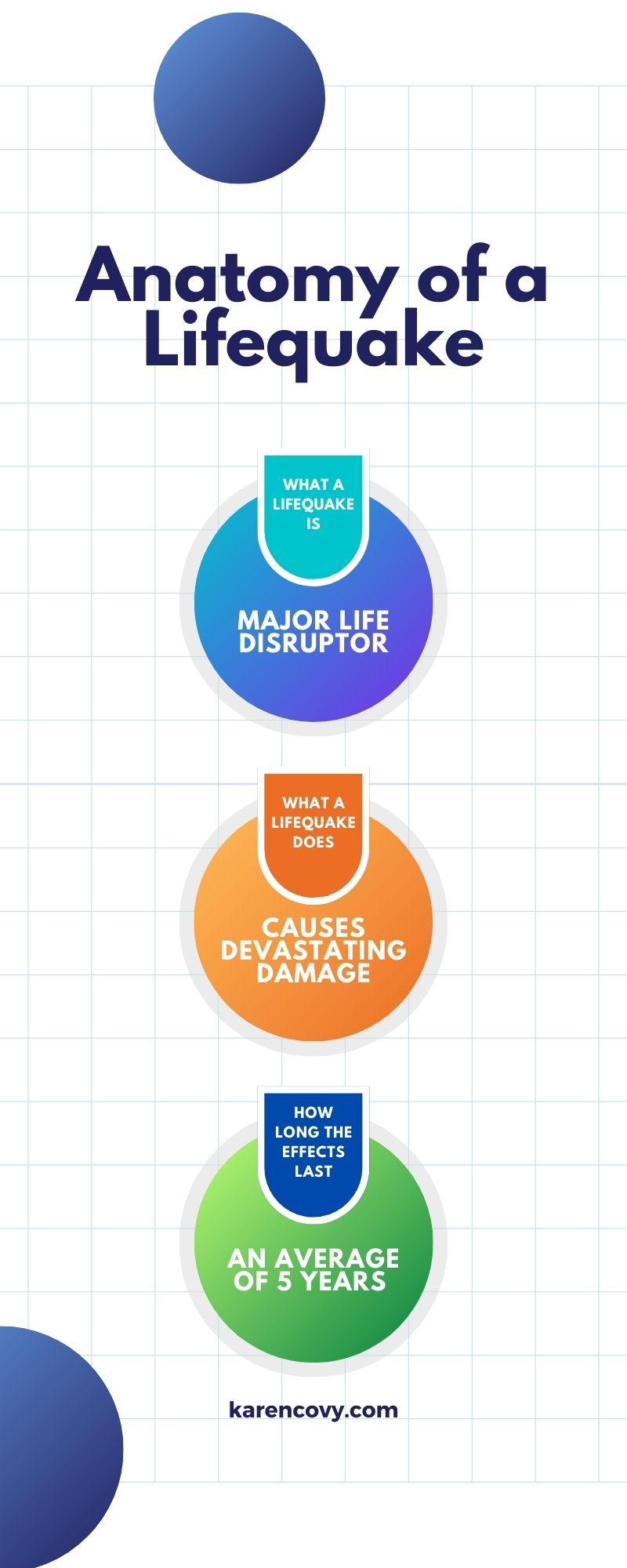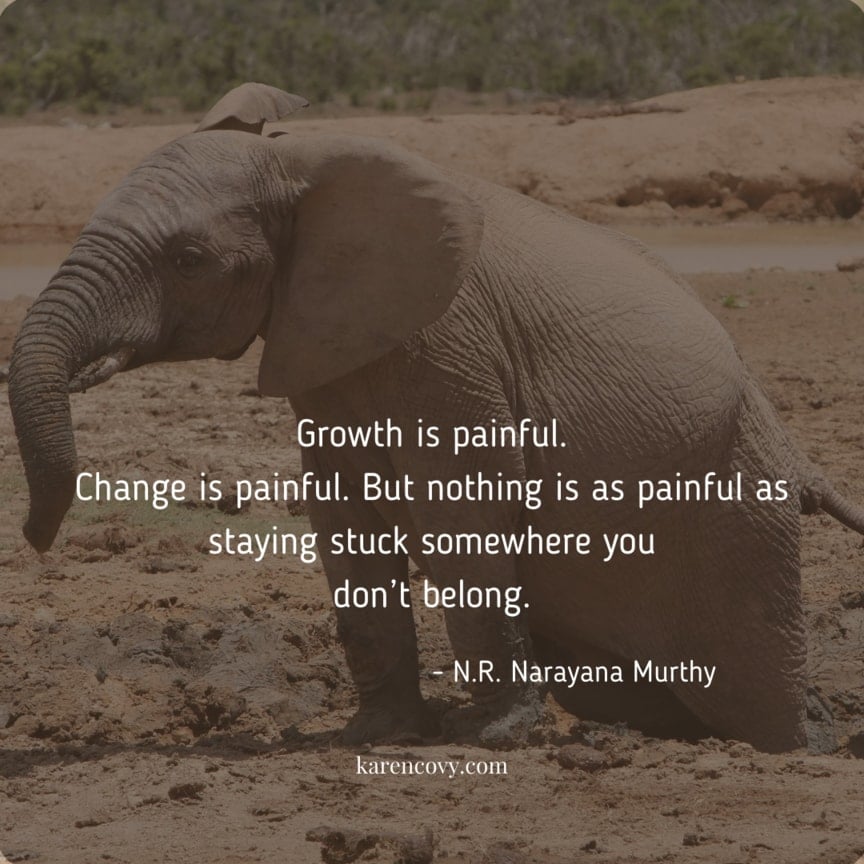There are life transitions, and there are “lifequakes.”
According to Bruce Feiler, the creator of the Life Story Project and the author of “Life is in the Transitions: Mastering Change at Any Age,” a lifequake is a life transition that disrupts your life so much that it rises to the level of truly disorienting or destabilizing you. Lifequakes cause devastating damage, and usually leave you reeling for years.
Run-of-the-mill life transitions, like having a baby or moving to a new house, disrupt your life. But they disrupt your life like a hurricane would. They throw everything up in the air and turn your life upside down. But if you run for cover and wait them out, you can usually escape with relatively minor damage.
(… and even if the damage is more severe, because regular transitions [like hurricanes] are at least somewhat predictable, you might have been able to plan for them in advance. Or, if you were really smart, you may have even had gotten insurance to protect yourself from their damage!)
Going through a lifequake, on the other hand, is like trying to survive a tsunami. They are massively destructive, impossible to prepare for, and usually they hit you out of the blue.
The good news is that navigating any kind of life transition (even a lifequake) is a learned skill.
But before we talk about the tools you can use to develop your own skill at mastering life transitions (and lifequakes) it helps to understand where these tools came from.

The Story of Bruce Feiler
Bruce Feiler was a writer in Savannah, Georgia. He came from a stable family and had a steady job. He was married and had twin daughters. By all accounts, life was treating him well.
Then he got diagnosed with a rare, aggressive bone cancer in his left leg. He went through surgery to remove his femur and struggled through sixteen rounds of chemotherapy.
After that, his father’s real estate business tanked during the Great Recession. His own job as a print journalist also suffered during the downturn. As a result, he emptied his savings and almost went bankrupt.
Meanwhile, his father, who had been living with Parkinson’s disease, went on a suicide spree. He tried to kill himself six times in twelve weeks.
In an attempt to re-focus his father on finding purpose in his life, Bruce started asking his dad to answer one question a week about his life. Those weekly answers turned into the story of his life.
Talking about his story changed Bruce’s father’s life. (Actually, it saved his life.) Then it changed Bruce's life.
Inspired by his father’s transformation, Bruce then spent five years traveling around the country asking interesting people to tell him their story. He gathered 225 stories from people who had gone through all kinds of problems, challenges and life transitions.
He spoke with people who had survived massive injuries, complete career changes, gender changes, divorce, and the death of a loved one. Then he organized and analyzed the information he had received and identified seven tools that people consistently used to get through their major life transitions.
7 Tools for Navigating A Life Transitions
While Feiler identified seven separate tools people used to navigate through lifequakes, he also found that no one uses all seven of the tools. But many people use more than one.
The tools roughly mimic the sequence of the life transition itself. Some tools are more appropriate for managing the beginning stages of a major life transition. Others are better used near the end.
Yet even though there is an "order" to these tools, people rarely use them in a specific sequence. Rather, they use whatever tool appeals to them whenever they want, and in whatever order they want.
Finally, the tools each person chose to use (or not) were highly individual.
Chances are, at least some of these tools will help you, too.

1. Accept It: Identify Your Emotions
The emotion most people feel the most when faced with a major life transition is fear. (That’s followed by sadness, shame, guilt, anger and loneliness.)
People going through a major life transition dealt with their fear in a number of ways.
One common technique they used to deal with their fear was to create a mental equation in which their fear of change was LESS than their fear of staying the same.
For example, one woman described how the life in her marriage was so unpleasant, that she was able to do something totally “non-normal” and leave her husband for her boss.
Another common technique people used to deal with their fears was to write them down. Many people who went through major lifequakes wrote down all their anxieties AND their hopes. Then they would keep their list nearby so they could see it all the time.
That simple act of identifying and writing down specifically what they were afraid of helped them to manage their fears.

2. Mark It: Ritualize the Change
Rituals have been a part of humanity for as long as we’ve existed on this planet. We have rituals celebrating birth and death. Ancient civilizations had rite-of-passage rituals that celebrated a youth’s transition into adulthood. While we no longer ritualize the passage into adulthood, we do still ritualize marriage.
When it comes to more negative life transitions, however, we don’t always have specific rituals to mark the situation.
While we do hold funerals when people die, there are no established rituals to use when you become a paraplegic, turn your career upside down, or get a divorce. (Although some people have started having divorce parties as a way to celebrate the beginning of their new life.)
Because so many of the major upheavals in our modern lives don’t come with ready-made rituals to mark them, many people have started creating their own rituals to mark the end of a transition.
They get tattoos, light candles, and build memorials. They host dinners, have parties and go on pilgrimages. Or they hold baptisms, join protests, and host empowerment groups.
All of these rituals help people to mark their transition in some outward way. That, in turn, allows them to let go of the emotions inside of them and move on more peacefully.

3. Shed It: Give up Old Mindsets, Routines and Ways of Being
Of all the techniques people use to navigate through a major life transition, shedding your former mindset, routines, and identity is definitely the most uncomfortable. Yet, it’s often both necessary and inevitable.
“Losing yourself” is often how you feel when you’re in the middle of your transition. Your old way of looking at the world no longer works for you. The habits, the routines, and even the friends you had, seem empty and out-of-touch. You feel like you’re in a “meaning vacuum.” There is no ground underneath your feet.
At the same time, you’re not ready to jump into something totally new either. You hesitate. You hold back. Yet, until you reach that state where you feel off balance, where you hit bottom, you’re not ready to climb back up.
To get through the time in their transition when they just can’t seem to grab hold of anything solid, people usually try to organize their life by taking one of three approaches: the sandbox, the quest, or the cycle.
The Sandbox Approach
The sandbox approach is exploratory. The idea is that you create your boundaries (the sandbox) then explore whatever you want within those boundaries.
Some common examples of the sandbox approach is when people change their appearance, redecorate their house, and re-arrange their lives. They try new things - things that seem completely out of character with the person they were before. Their sandbox becomes their playground.
The Quest Approach
The quest approach is exactly what it sounds like it is. It's "going on a quest." It is the classic "hero's journey." When people go on a quest they start searching for something.
People may go on a quest for sobriety. They may enroll in classes. Or they may start a new business. They may go on a road trip, run a race, or embark on a journey of self-discovery. All of those are types of "quests" that help people create a new identity and a new way of looking at the world.
The Cycle Approach
The cycle approach loops experiences in repeatable cycles. The goal is to perform better as you continue going around each loop.
Taking up meditation, beginning to journal, or engaging in religious practices are all cyclic activities. You practice them over and over again. The more you practice, the more you grow and the more meaning you create for yourself.
4. Create It: Try New Things
While most people don’t think of life transitions as being particularly creative, there are reasons that art therapy, music therapy, and journaling exist. Using any form of creative expression turns out to be a phenomenal way to re-create your life after you’ve gone through a major transition.
When their whole world has fallen apart, people start to dance, sing, cook, write, draw, paint and play music – even if they had never done those things before. It turns out that taking a creative approach to transitioning your life can be surprisingly healing.
For example, in 1986 psychologist James Pennebaker conducted an experiment in which he asked a group of students to write about a traumatic life experience they had. They wrote for fifteen minutes a day for four days.
At the end of the experiment, students reported an increase in their level of sadness and anxiety. But several months later Pennebaker found that:
“People who write about their most stressful life experiences develop greater insight into their emotions, can express themselves more fully, (and) even show evidence of a strengthened immune system.”
(Life is in the Transitions, p. 231)
People have also experienced tremendous growth through their life transitions by engaging in a variety of creative endeavors. Those endeavors include much more than drawing or painting. Some people have expressed their creativity by changing their body. They've taken up a new sport, gone vegan, or engaged in extreme sports. All of those activities had a transformative effect on the people who pursued them.

5. Share It: Seek Wisdom from Others
Human beings are social creatures. We get tremendous value from sharing our stories and our lives with others. We get even more value from the feedback others give to us.
The feedback we seek comes from a variety of different people. The people we go to for advice and support during a major life transition depend on who we are, and what type of people we feel comfortable around.
Feiler discovered that there were five types of people we seek feedback from during a major life transition: comforters, nudgers, slappers, modelers, and naysayers.
Comforters are exactly what they sound like they are. They are those who comfort and encourage you. (Most transitioning people preferred to confide in comforters.)
Nudgers came in second. Nudgers are those who are supportive, but gently encourage you to try something new, or see things in a different way.
Slappers used a more direct approach. For example, they might say, “I love you but get over yourself.” Slappers are third on the list of people who those in transition preferred to talk to during their transition.
Next in line were modelers. Those were people who led by example. They could not only listen to the transitioning person’s struggles, but also model productive ways to overcome those struggles.
Finally, naysayers are those who tell us we can never do whatever it is we are trying to do. While it may seem odd that people who were struggling through a rough life transition would go to a naysayerfor support, for some people, they were motivational.
Hearing someone tell them what they could NOT do drove them to prove to that person what they COULD do.

6. Launch It: Unveil Your New Self
As people pass through their life transition, there comes a time when they start coming through it. When that time comes, they then unveil their new self.
While"launching your new self" may sound grandiose, a “launch” doesn’t have to be a media-worthy event. In fact, usually it’s not.
Usually, your "launch" begins in baby steps. It begins when you have your first normal moment.
Finally, while a launch doesn't necessarily have to be big, it does have to be public. You can't go through a "launch" unless there's someone other than you who's around to witness it.
For example, Feiler tells the story of Chris Waddell, a promising young skier who broke his back on a ski slope. After spending months being depressed, Chris’ college coach took him to New Zealand to join the US Paralympic team.
On his first day there, he was terrible. But later that week when he made his first curve on a monoski he knew he would make the team. That was his “launch.”
Waddell later won medals as a sit skier in the 1992, 1994, 1998 and 2002 Winter Paralympics.
7. Tell It: Compose a Fresh Story
The last tool for navigating through a major life transition is, according to Bruce Feiler, arguably the most important. It’s updating your personal story.
(This is especially important when it comes to your divorce story. What you tell yourself about your divorce can hold you back and keep you mired in bitterness for years. Or it can set you free.)
We all have a story of our life. Through our story, we make sense of our life. We give it meaning.
When we go through a major life transition, our life story has to change. The person who exits the transition is not the same person as the one who entered it. Re-writing our story, the narrative of our life, completes the creation of our new self.
How do you do that?
Feiler identified three important components that a post-transition life story must have.
First, it has to put distance between the major life event and the place where the person is now. Until you can talk about a major life transition in the past tense, you’re not ready to compose a new story about it.
Second, your new story must use positive language. You must be able to envision a positive future for yourself, even if you’re not yet at the point where you ultimately want to be.
Finally, you have to nail the ending. You have to tell your story in such a way that it allows others (and you!) to take something beneficial away from it. Once you can do that, you will have put your transition behind you.

Navigating Life Transitions is a Process
Like it or not transitions are a part of life. If Bruce Feiler’s research is right, they’re also happening more often than they did in the past. According to Felier the average person goes through three to five major transitions in their adult life. Each transition tends to last between three to five years. When you do the math, that means that most people spend a substantial part of their adult life dealing with life's major transitions.
That statistic applies to everyone. Rich, poor, young, old, educated, or uneducated - everyone experiences major, world-rocking life transitions. Living a life without any major transitions or lifequakes is simply not possible.
The truth is, as much as we hate going through a rough transition, living a life without them would eventually get boring. It would be a life of stagnation.
As painful as they can be, it is through our life transitions that we grow. Even the lifequakes can bring us tremendous benefits once we have navigated through them.
Knowing that so many others have survived their own major life transitions, and knowing how they did it, provides us with invaluable tools we can use in our own lives. Hopefully, you can use some of these tools to make your own lifequake a little easier to manage.
_______________
This article relays just a small piece of the wisdom you can find in Life is in the Transitions: Mastering Change at Any Age. If you really want to become a master at managing your life transitions, I highly encourage you to get Bruce Feiler’s book and read the whole thing.
This article was originally published in October, 2020, and updated on August 17, 2023.

